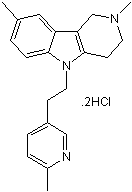| DC46842 |
Cipralisant maleate
|
Cipralisant (GT-2331) (maleate) is an orally active, low-toxicity, potent, selective, high affinity histamine H3 receptor full antagonist in vivo, and an agonist in vitro, with a pKi of 9.9 for histamine H3 receptor and a Ki of 0.47 nM for rat histamine H3 receptor. Cipralisant (maleate) has the potential for attention-deficit hyperactivity disorder research. |
| DC46433 |
JNJ-39758979 dihydrochloride
|
JNJ-39758979 dihydrochloride is a selective, orally active, and high-affinity histamine H4 receptor antagonist, with Kis of 12.5, 5.3, and 25 nM for human, mouse, and monkey histamine H4 receptor, respectively. JNJ-39758979 dihydrochloride functionally antagonizes histamine-induced cAMP inhibition with a pA2 of 7.9 in transfected cells. JNJ-39758979 dihydrochloride shows good anti-inflammatory and antipruritic activity. |
| DC45797 |
Methapyrilene hydrochloride
|
Methapyrilene (Thenylpyramine) hydrochloride is an orally active H1-receptor antihistamine and an anticholinergic agent of the pyridine chemical class. Methapyrilene hydrochloride has hepatotoxicity and can be used as a hepatotoxin that cause periportal hepatic necrosis in vivo |
| DC45376 |
(Z)-Lafutidine
|
(Z)-Lafutidine ((Z)-FRG-8813) is a potent histamine H2 receptor antagonist. (Z)-Lafutidine shows anti-secretory and gastroprotective activities. |
| DC44555 |
Promethazine
|
Promethazine is a potent histamine H1 receptor antagonist. Promethazine is a medication used in the management and treatment of allergic conditions, nausea and vomiting, motion sickness, and sedation. Promethazine exhibits antiparasitic properties. |
| DC44554 |
Levocetirizine
|
Levocetirizine (LCZ, (R)-Cetirizine), the R-enantiomer of cetirizine, is an antagonist of histamine H(1) receptor. |
| DC42500 |
Levocabastine hydrochloride
|
Levocabastine hydrochloride is a long acting, highly potent and selective histamine H1-receptor antagonist with anti-allergic activity. Levocabastine hydrochloride is also a selective, high affinity neurotensin receptor subtype 2 (NTR2) antagonist, with a Ki of 17 nM for mNTR2. |
| DC42309 |
Betazole
|
Betazole (Ametazole), a pyrazole analogue of histamine, is an orally active H2 receptor agonist. Betazole induces gastric acid secretion, and causes an immediate and significant increase in common bile duct pressure. Betazole has been used as a diagnostic agent known as histalog, for investigating gastric acid secretory capacity. |
| DC41413 |
Psoralenoside
|
Psoralenoside is a benzofuran glycoside from Psoralea corylifolia. Psoralenoside exhibits high binding affinities against histaminergic H1, calmodulin, and voltage-gated L-type calcium channels (E-value≥-6.5 Kcal/mol). Psoralenoside?shows estrogen-like activity, osteoblastic proliferation accelerating activity, antitumor effects and antibacterial activity. |
| DC41275 |
Betahistine mesylate
|
Betahistine mesylate is an orally active histamine H1 receptor agonist and a H3 receptor antagonist. Betahistine mesylate is used for the study of rheumatoid arthritis (RA). |

 To enhance service speed and avoid tariff delays, we've opened a US warehouse. All US orders ship directly from our US facility.
To enhance service speed and avoid tariff delays, we've opened a US warehouse. All US orders ship directly from our US facility.




















